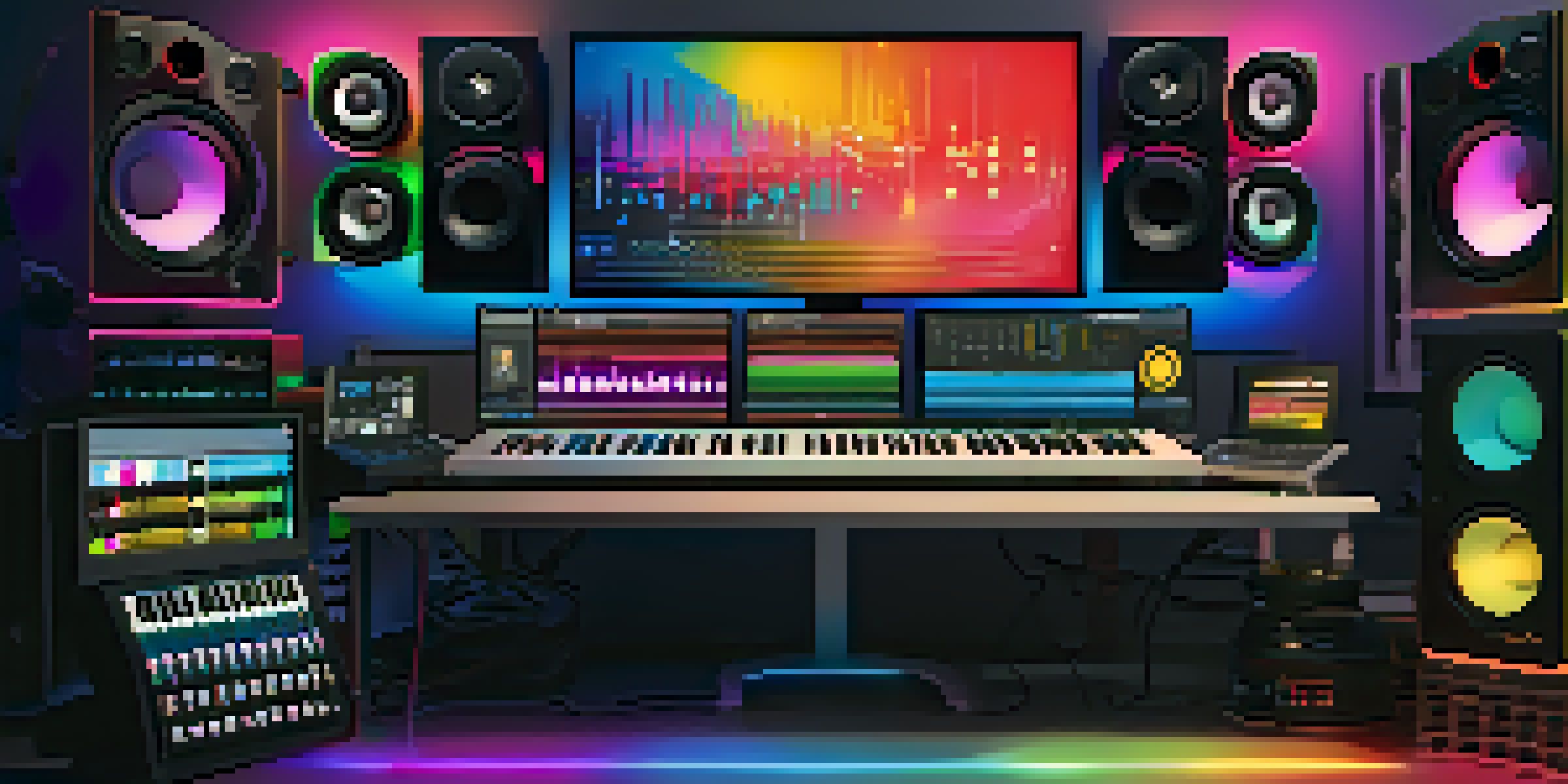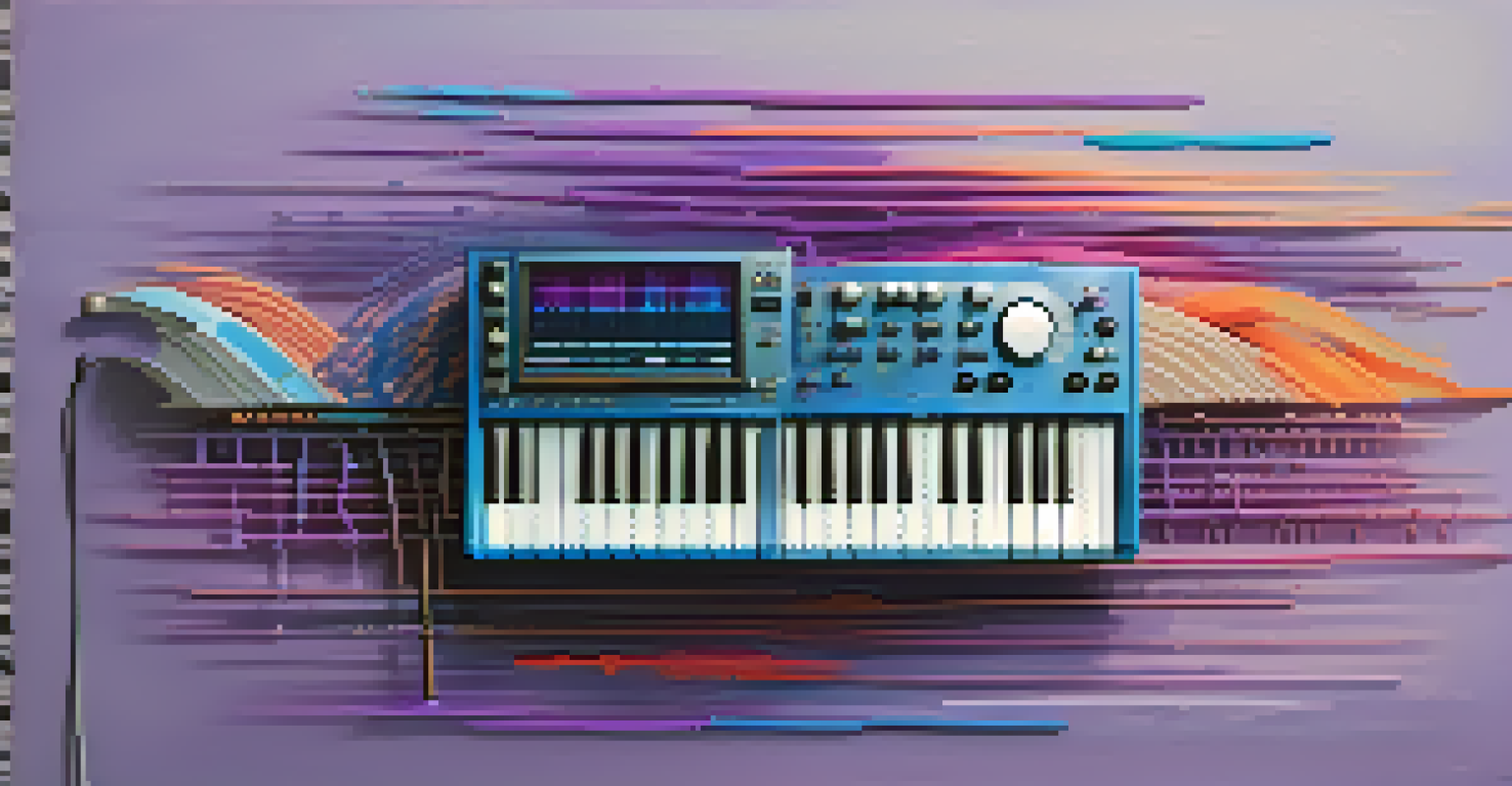Creating Loops and Beats: Techniques for Modern Music Producers

Understanding the Basics of Loops in Music Production
Loops are short sections of audio or MIDI that repeat seamlessly in a track. They can range from a few beats to several bars, providing a foundation for your music. By using loops, producers can create textures and layers that add depth to their compositions.
Music is the shorthand of emotion.
To get started with loops, think about the mood or genre you want to capture. For example, a hip-hop beat might benefit from a heavy kick drum loop, while an ambient track could use airy synth loops. Understanding these foundational elements helps you build your sound effectively.
Remember, loops are not just about repetition; they can evolve over time. By subtly altering a loop—such as changing its pitch or adding effects—you can keep the listener engaged while maintaining a cohesive sound.
Choosing the Right Software and Tools for Loop Creation
Selecting the right Digital Audio Workstation (DAW) is crucial for modern music production. Popular options like Ableton Live, FL Studio, and Logic Pro offer user-friendly interfaces and powerful features specifically designed for loop creation. Each DAW has unique strengths, so pick one that aligns with your workflow.

Beyond the DAW, consider using virtual instruments and sample packs to expand your sonic palette. Sample packs provide pre-recorded loops and sounds that can save you time and spark creativity. For example, a high-quality drum kit can instantly elevate your beat-making process.
Loops Enhance Music Composition
Using loops allows producers to create rich textures and layers, forming a solid foundation for their tracks.
Finally, don't overlook the importance of MIDI controllers. Devices like drum pads and keyboards allow for hands-on play, making it easier to create dynamic loops. This tactile experience can inspire new ideas and enhance your production skills.
Layering Sounds: Building Complex Loops and Beats
Layering is an essential technique for creating rich and engaging loops. By combining different sounds—like a kick drum, snare, and hi-hat—you can develop a fuller rhythm that keeps the listener's interest. Think of it like painting; each sound adds a different color to your musical canvas.
The beautiful thing about music is that it transcends language.
To effectively layer sounds, consider their frequency ranges. Ensure that each layer occupies its own space in the mix; for instance, a deep bassline complements a bright synth without clashing. Use EQ (equalization) to carve out frequencies, making room for each element to shine.
Experimentation is key when layering. Try out various combinations and adjust the volume levels and effects until you find a blend that resonates. Sometimes, unexpected pairings create the most compelling loops and beats.
Incorporating Rhythm and Groove into Your Beats
Rhythm is the heartbeat of any track, and understanding groove can elevate your music significantly. Groove refers to the feel and swing of a beat, which can make it more danceable and engaging. Think about how a slight delay or swing can give your loop an infectious rhythm.
To incorporate groove, you can use quantization settings in your DAW. Quantization aligns notes to a grid, but by adjusting the swing settings, you can create a more organic feel. This technique is particularly effective in genres like funk and hip-hop, where groove is paramount.
Choose the Right Tools
Selecting an appropriate DAW and utilizing MIDI controllers can significantly improve the loop creation process.
Additionally, listen to your favorite tracks and analyze their rhythmic structures. What elements make them feel good? By deconstructing existing music, you can better understand how to apply similar techniques to your own productions.
The Art of Sampling: Transforming Existing Sounds
Sampling is a popular technique that involves taking snippets of existing recordings and incorporating them into your music. This can range from using a small vocal clip to a full instrumental phrase. The beauty of sampling lies in its ability to breathe new life into familiar sounds.
When sampling, it's important to consider copyright laws. Always ensure you have the rights to use the samples you choose, or opt for royalty-free samples. Many producers create unique tracks by creatively manipulating samples, making them unrecognizable and entirely fresh.
Experiment with pitch shifts, time-stretching, and effects to transform your samples. For instance, slowing down a vocal sample can create a haunting atmosphere, while chopping it into smaller pieces might add a rhythmic flair. The possibilities are endless!
Using Effects to Enhance Your Loops and Beats
Effects play a crucial role in shaping the sound of your loops and beats. Reverb, delay, compression, and distortion can add depth and character to your music. For example, applying reverb to a snare drum can create a spacious sound, making it feel more immersive.
When using effects, moderation is key. Overdoing it can muddy your mix and detract from the clarity of your loops. Start with subtle applications, gradually building up until you find the right balance that enhances your sound without overwhelming it.
Experiment with Sound Layering
Layering different sounds thoughtfully and experimenting with effects can lead to more engaging and dynamic loops.
Additionally, experiment with automation to create dynamic changes in your effects throughout the track. Automating parameters like reverb levels or filter cutoff can add movement, helping your loops evolve and keeping the listener engaged from start to finish.
Finalizing and Exporting Your Loops for Use
Once you've crafted your loops and beats, it's time to finalize and export them. This process involves mixing your elements to ensure they sound cohesive together. Pay attention to levels, panning, and effects to create a polished sound that translates well across different playback systems.
Before exporting, consider doing a final listen on various speakers or headphones. This helps you catch any inconsistencies and allows you to make necessary adjustments. Remember, what sounds good on one system might not translate well on another.

Finally, when exporting your loops, choose the appropriate format. WAV files offer high quality, while MP3s are more versatile for sharing. Once exported, you can easily incorporate your loops into future projects or share them with other producers, expanding your creative network.